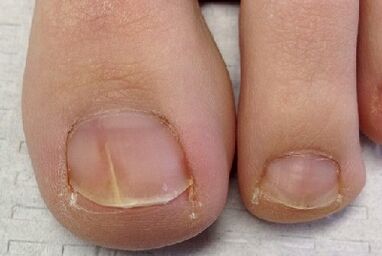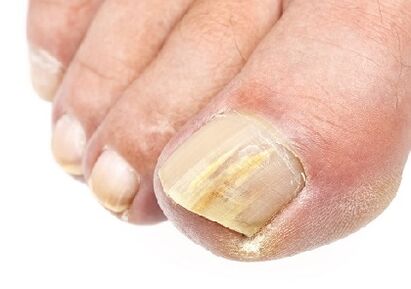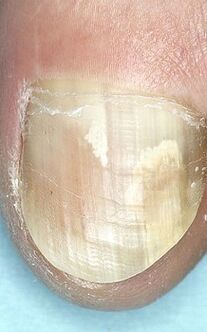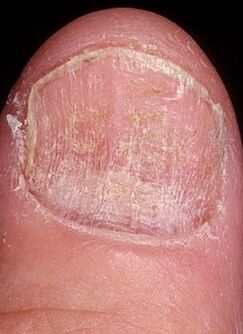
Every third person on Earth came across a problem such as stratification and cringing of nails, clouding of the plate - this is onychomycosis.The disease affects various age groups.The fungus of nails on the legs (photos are presented below), quickly spreads and adapts to new conditions.
We will consider in more detail the main factors of the occurrence, types and methods of treating fungus at home.
Classification
The causative agents of this disease are saprophytes, mold fungi, candida and other pathogenic microorganisms.
The main types of pathogens of the disease:
- Epiderrnophyton Floccosum.Anthropophilic fungus, which affects the stingy layer of the epidermis.After infection on the skin, pink peeling spots with characteristic vague edges begin to appear.It is transmitted with tactile contact or through household items.
- Trichophyton Rubrum and Trichophyton Mentagrophytes.These are two yeast -like mushrooms from the genus Trichophytons.They have a toxic effect, are able to stay in a sleeping state for a long time, and after exposure to negative factors to activate.The first signs of the disease are itching between the fingers and an unpleasant odor, a rash and peeling later appear.The color of the integument may remain unchanged.
Mycologists distinguish four varieties of mycosis, which can be caused by various fungi of the foot:
- The erased form is the easiest.It is characterized by insignificant itching between the fingers and the light peeling of the skin.The reason is Saprofit Candida.Its incubation period is 2 weeks.Most often, patients simply do not notice the signs of infection and are the distributors of the fungus.Even in the absence of treatment, the disease passes by itself.
- Squamine -hyperkeratotic.The advanced shape of this foot fungus can cause the appearance of deep cracks and damage to the tissues of the leg up to the ankle.It is noteworthy that at the initial stage of the disease there are no external manifestations.The sole does not itch and does not hurt, occasionally small cracks arise;
- Intriginous or interpassum - the most common.Most often, the primary lesion begins with the fold of the thumb and forefinger, then spreading along the foot.Possible causes of occurrence are contact with an infected person (surface), injuries and non -compliance with personal hygiene rules;
- Dyshidrotic or vesicular form - mycosis, which provokes the appearance on the epidermis of rashes and local erosions.It is transmitted exclusively from the patient and is extremely rarely diagnosed on the skin of the legs.It is believed that this fungus loves brushes and palms more.In the absence of proper treatment due to the effects of pathogenic microorganisms, mycotic eczema occurs.
Over time, fungal lesions progress, although this happens extremely slowly.Sometimes people live with fungi for decades and begin to worry only when the nail completely leaves, painful sensations appear.There are several stages in total.
- The initial stage.The fungal infection is just beginning to destroy the nail, its color changes, transparency disappears.
- The appearance of hyperkeratosis.This phenomenon, when with mycosis, the nail begins to thicken, becomes very dense, sometimes it grows strongly.Towards the end of this stage, the nail plate becomes loose, sometimes its upper layers can simply scrape your finger.
- At the next stage, the fungal infection moves under the nail.The cuticle is separated from the nail plate, the nail roller can blush, swell and become inflamed.
- Running stage.The nail is atrophied, it completely changes color.At this stage, the nail plate often completely departs or destroys.
It is advisable to suspect the fungus of nails in the initial stages, in an advanced form it is difficult and treated for a long time, sometimes it is necessary to completely remove the nail plate.Do not run mycosis.
Symptoms
Onychomycosis most often affects the nails on the legs, hands suffer less often.The disease begins with the thumb and little finger (the external edge is touched), smoothly affecting all the plates.
The leading symptoms of onychomycosis will help determine the fungal infection (see photo):
- the appearance of strips and spots of a whitish or greenish tint under the nails;
- clouding of the plate, a change in its color (from yellow to dark brown);
- redness and peeling of the skin around the nail;
- the appearance of roughnesses on the feet and between the fingers;
- The formation of mold on the nails.
To know how to recognize the disease in the initial stage, you can see the main manifestations of nail fungus in the photo.This will at least approximately understand how the development of infection begins, and in the event of similar signs, consult a doctor.

What does the fungus look like in the photo
In any case, the initial inspection of the legs is carried out independently.In order not to confuse the fungus with possible corns or ordinary mechanical damage to the foot, we recommend that you study the photos of the nail fungus in the initial stage.
Diagnostics
There are more than 50 subspecies of fungi causing onychomycosis, so you can accurately determine the species only in laboratory conditions.Preliminary diagnosis at home is possible from the second stage when symptoms appear.
- It is necessary to inspect the nail plates to determine the localization of a fungal infection.
- The next criterion is the form of changing the thickness of the nail, the presence of peeling scales and cringing.
- The determining factor may be the color of the foci of infection.
- It is necessary to evaluate the condition of the skin and hair at the time of the detection of onychomycosis: many fungi affects them first, and then switch to nail plates.
In some cases, the pathogen is several types of fungal infection.Combinations of dermatophytes with yeast -like fungi or molds with candidates are possible.
Treatment of nail fungus in the initial stage
In the event of such a disease, 3 treatment options are possible, it all depends on the stage at which the fungus is located.So this is:
- use of local drugs;
- use of oral drugs;
- Combined therapy.
- Local drugs are represented by various ointments, gels, suspensions, emulsions and other types of external drugs.They act only on the lesion and do not penetrate the blood.They are used mainly in the early stages of the development of dermatomycosis or with a small focus of infection.Treatment, as a rule, is from a week to several months, depending on the neglect of the lesion.
- Periral drugs are taken inside and affect the pathogen from the inside of the body.They have side effects and affect not only the affected area, but also the body as a whole.In some cases, there is enough single use, sometimes a course of treatment is required.They are used for severe lesions and advanced stages of fungal diseases.
- Combined therapy is used more often.The action of external drugs reduces the intensity of symptoms, accelerates the healing of damaged areas, and the tablets act from the inside on the pathogen.

With any treatment option, the course of therapy cannot be interrupted.The diagram of the use of drugs and the duration is determined by the doctor.As a rule, treatment continues after the disappearance of the symptoms and external manifestations of mycoses for several more days (up to a week).
Varnishes and ointments against the fungus
If the nail fungus is not neglected, but is at the initial stage, you should try to use varnishes and ointments that help soften the affected area.In this case, the spores of the fungus die under the influence of the drug.
For the treatment of the nail, select one type of drug.It is not recommended to alternate, change funds, such manipulations will lead to a decrease in the effectiveness of therapeutic effects.Before starting use, be sure to read the contraindications.Pregnant women and people suffering from individual intolerance to use antifungal varnishes for treatment.
Before applying varnish or ointment, it should be removed as much as possible with a fungus area of the nail using a special file that comes with the medicine.With a degree of nail by water-alcohol solution, a layer of varnish is applied, which should be changed every few days.Before the procedure, you can take a soap-soda foot bath.The varnish is removed in the same way as decorative, using organic solvents.
Traditional medicine
Mycosis of nails in the initial stage can also be treated with home methods.Folk remedies are good assistants in the complex therapy of the disease.
- Sea salt.This tool is best combined with conservative treatment methods.Baths with sea salt - recommended preparatory procedure before applying local funds.You need to take one teaspoon of salt for a small amount of hot water, keep your legs for about 15-20 minutes.
- Baths from a decoction of vertical branches are used 3 times a week.To prepare, collect young shoots, finely chop, take 500 gr.raw materials and pour 2 liters of water.Boil, reduce the fire and withstand for 10 minutes.After cooling the decoction, strain it and keep your legs for 20 minutes.
- Tea tree oil.Injured nails must be lubricated before bedtime, bandaged and leave overnight.In the morning, remove the bandages, clean the nail from the keratinized layer and again drip tea tree oil, but no longer wrap it up.It is important to continue treatment until a healthy nail begins to grow.
- Acetic baths.In 2 liters of hot water (37 degrees), dilute 5 tbsp.l.9%vinegar.The legs must be soared in such a solution for at least half an hour.Next, clean the softened, keratinized layer of the nail with a file, and treat the affected areas on the feet and between the fingers with a pumice.After such manipulation, it is recommended to apply an antifungal cream or solution.The procedures do regularly (1-2 times a day) within a month.
- Celandine.This plant has long been used against diseases of nails and skin.It is necessary to handle it carefully due to the active “cauterizing” effect.Cutual juice, decoctions and oils based on this plant are used against the fungus.

Laser therapy
Laser therapy is one of the latest methods of treating nail fungus, especially in the later stages.This method is an alternative to surgical removal, after which a long recovery period follows.With laser treatment, healthy tissues are untouched, during the procedure the patient does not experience pain and other unpleasant sensations.
Cons of laser treatment: High price, between the procedures you need to take breaks, only a qualified dermatologist can conduct them.Regardless of the selected method of therapy, it is necessary to follow all the rules of personal hygiene.The nail fungus can recur, the treatment will not be effective if this is not done.
In the treatment of nail fungus on the legs, you need to regularly carry out hygiene procedures, often change socks, ventilate shoes after socks.The same rules must be followed so that mycosis of nails does not occur again after treatment.
Prevention
Of course, it is better to warn the fungus than to fight its consequences for a long time.
How to protect yourself from the fungus:
- At the first signs of the fungus (itching, redness, peeling), you need to lubricate the feet abundantly with a special ointment with antibacterial and moisturizing the skin with the effect;
- Before each visit to the pool, sauna, gym or other place where you need to take off, it is important to treat the skin with protective cream;
- Regularly process shoes, wash it if possible and dry it in the fresh air.It is not necessary to use special compositions for this.Most products can be wiped from the inside with alcohol or other antibacterial solutions.
To strengthen the skin and provide local immunity, a recipe for a preventive mixture based on onions is suitable.One onion is rubbed with two tablespoons of honey.The resulting pasta is applied to the skin of the feet and palms.It is advisable to withstand the mask for 30 minutes.Repeat every other day.
















